Growing tomatoes in pots is a great option if you don’t have a large plot or a good spot for them in your garden. In this post, I’ll show you all you need to know in order to be successful.

Whether you’re lacking garden space, or just want to give a different method a try, growing tomatoes in pots can be both fun and productive.
But keeping them in containers is a little different than when they’re in the ground.
In this detailed guide, you’ll get all the tips you need to successfully grow tomatoes in pots.
From choosing the right variety, container, and soil, to how to water and fertilize them, and much more.
Growing Tomatoes In Pots vs The Ground
If you’re trying to decide between growing tomatoes in pots vs the ground, there are definitely advantages to using containers.
The main one is that you can put them anywhere. If you have a shady yard, it allows you to maximize any sunny spots, whether that’s a patio, porch, balcony, or even your driveway.
It also reduces the risk of disease and pest issues because you’re starting with clean, fresh soil.
Plus it’s a space saver! You can put a huge range of plants in a much smaller area, anywhere the sun shines. Heck, you could even hang them if you want.
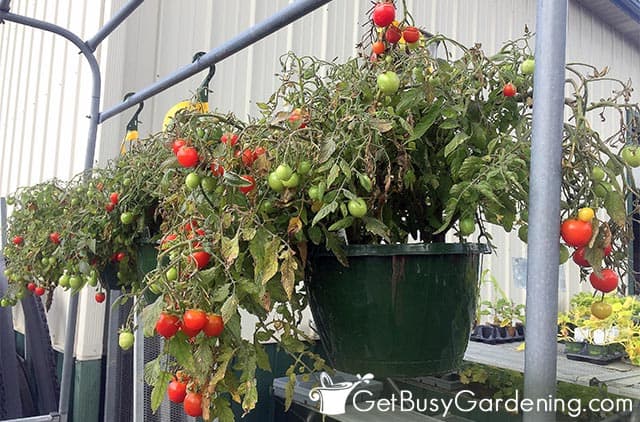
How To Grow Tomatoes In Pots
Choosing the right type of plant, the best size container, and the proper soil are essential for healthy tomatoes in pots. Let’s talk about how to give them the perfect home.
Best Tomatoes To Grow In Pots
Any tomato can technically be grown in a container. Even the largest indeterminates are possible with a big enough pot, but not very practical.
Determinate tomatoes (aka: “patio” or “bush” varieties) on the other hand are much smaller, more compact, and the best choice for use in containers.
So make sure to look for those keywords on the plant tag or packet. Here are a few of my favorites.
- Snacking – Glacier Bush, Tumbler, or Tiny Tim all produce sweet fruits that are excellent for snacking.
- Paste – Roma or Pik Red varieties are great for canning or making pastes and sauces.
- Slicing – Marglobe, Celebrity, Red Pride, or Bush Steak are perfect if you’d like the bigger fruits for sandwiches and salads.
Related Post: How To Tell Determinate vs Indeterminate Tomatoes

Different Types Of Pots For Tomatoes
When it comes to choosing a pot for your tomatoes, bigger is best. Ideally it should be at least 18” in diameter, and a foot deep.
A large container, 15 gallons or more, can ensure the roots have plenty of space, giving them a better chance at producing more fruit.
It’s also essential that it has drainage holes in the bottom. Waterlogged soil is a quick way to develop root rot, and kill your plant.
As for what it’s made of, there’s a wide range of materials you can choose. Some people prefer fabric or terracotta to reduce the risk of overwatering. Clay also tends to be heavier and less likely to tip over.
Plastic is inexpensive and retains moisture well. In very hot climates however, it can also hold too much heat, which may damage the plant.
Related Post: Tomatoes Not Turning Red? Try These 5 Tricks
Choosing The Right Kind Of Soil
For the healthiest tomatoes make sure to use a fertile, well-draining container potting soil. A lightweight medium that’s enhanced with organic material is ideal.
There are many pre-mixed options you can buy, or you can make your own by mixing peat moss or coco coir with compost, perlite, and vermiculite. See the full recipe here.
It’s also key to always use fresh, sterile soil. Reusing last year’s mix or taking it from your garden is never a good idea, and can cause pest problems, disease, soil compaction, and stunted growth.
Planting Tomatoes In Pots
One major benefit of growing tomatoes in containers is that you can transplant earlier than you would be able to in your garden.
If a cold snap is coming, simply move them indoors overnight to protect them.
When it’s time to plant, nestle your starts deeply. Bury the stem all the way up to the first set of true leaves.
Roots will form all along the buried stem, and result in a stronger, sturdier system that can absorb nutrients and water better.
Related Post: How To Grow Tomatoes From Seed & When To Start
How Many Tomato Plants Can I Put In One Pot?
It’s important to only grow one tomato plant per pot, no matter how large it seems when they’re still small.
They develop large, spreading roots that are nutrient and water-hungry. Having competing plants in one container will stunt them and make them both poor producers.
Related Post: How To Can Cherry Tomatoes
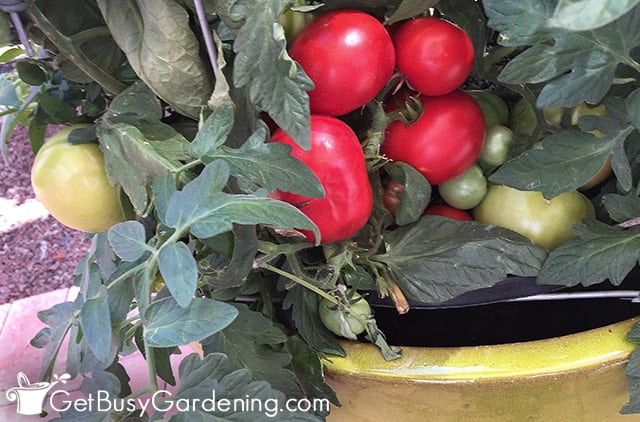
How Do You Take Care Of A Potted Tomato Plant?
Once you understand what tomatoes need, it isn’t any more difficult to grow them in pots. You can find my full care guide here, but in this section you’ll find detailed tips on how to keep them thriving in containers.
Watering Tomatoes In Pots
Proper watering is especially important for containerized tomatoes, since they’ll deplete the moisture much quicker in pots than they would in the garden.
This is why issues like cracking and blossom end rot are much more prevalent. Keep the soil evenly moist by deeply watering every couple of days, rather than giving them small drinks every day.
In hot weather, especially in pots made from porous materials, you may need to check multiple times a day.
If the soil is dry a few inches down, they need a drink. A moisture meter will tell you when it’s time.
Using self-watering containers or drip irrigation may help you keep them from drying out without requiring as much hands on attention.
Related Post: When To Pick Tomatoes & How To Harvest Them
Fertilizing Containerized Tomatoes
Fertilizing is also very important for potted tomatoes. Not only do they use up nutrients much faster, but every time you water, some of it is washed away out the drainage holes.
Since they can’t get what they need naturally from the ground, you’ll have to replenish it for them.
Start at planting time by adding organic granular fertilizer or worm castings to the hole, and continue to side-dress them monthly.
Liquid options, like compost tea or fish emulsion, can also be applied weekly.
Related Post: Quick & Easy Pickled Green Tomatoes Recipe
Pruning Tomato Plants In Pots
You don’t need to prune tomatoes in containers as often as you might in the garden, but it can help them produce better.
Simply pinching the suckers as they develop will help focus more energy on fruiting. But, if it’s getting too top heavy and falling over, you can cut it down to a more manageable size.
The bottom leaves and any branches that aren’t flowering or bearing fruit are safe to remove. Get more details on how to properly pruning them in this guide.
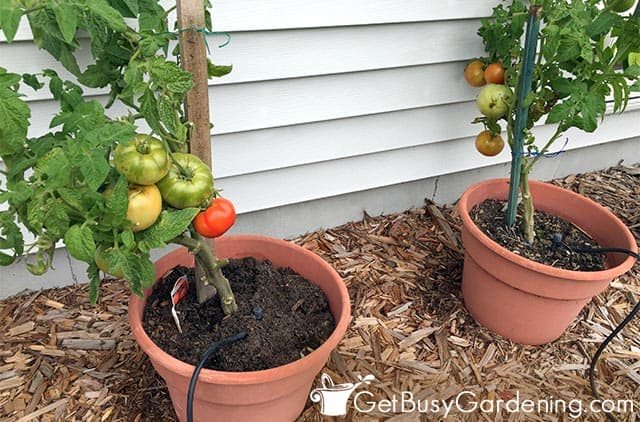
Supporting Potted Tomato Plants
Despite the typical container tomato being a bush variety, they’ll still require support as the branches become heavy with fruit.
Simple staking or using wire cages is often more than enough. Always place them at the time of planting. Waiting until later in the season can cause root or branch damage.
Related Post: How To Make Sturdy DIY Tomato Cages
FAQs
Here I’ve answered some of the most commonly asked questions about how to grow tomatoes in pots. If yours isn’t on this list, please ask it in the comments section below.
Do tomatoes grow well in pots?
Yes, tomatoes can grow very well in pots when given the right amount of attention, water, fertilizer, and sun.
How long does it take to grow tomatoes in a container?
How long it takes to grow tomatoes in containers depends largely on the variety you chose. However, many of the smaller ones produce earlier, some as soon as 50 days after germination.
Do tomatoes grow better in pots or in the ground?
Tomatoes can grow very well in either pots or in the ground. Compact varieties are better suited to containers, while the larger ones are best for the garden.
Can you put two tomato plants together in one container?
No, you should not put two tomato plants together in one container. They’ll compete for space and resources, and neither will be able to flourish.
How big should a container be for tomatoes?
The container you use for tomatoes should be fairly big. The ideal size is at least 18” in diameter, or 15 gallons. Choosing a larger pot is the safest way to ensure the plant has plenty of space to form strong roots.
How deep do containers need to be for tomatoes?
Containers need to be at least 12” deep for tomatoes. But deeper pots will give them more space to flourish, and can help them produce more fruit.
Growing tomatoes in pots can be very productive, and comes with tons of benefits. With the care tips in this guide you’ll know what varieties to choose, and how to keep them healthy throughout the season.
If you want to learn how to grow your favorite veggies up rather than out, then you should buy a copy of my book Vertical Vegetables. It’ll show you all you need to know, including 23 projects, to make the best use of your space.
Learn more about my Vertical Vegetables book here.
More About Container Gardening
Share your tips for growing tomatoes in pots in the comments section below.
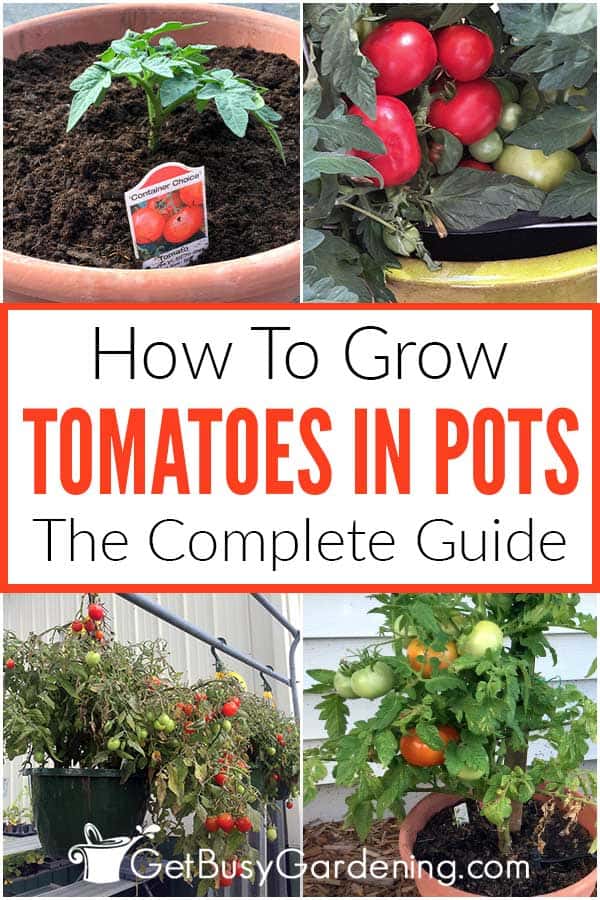
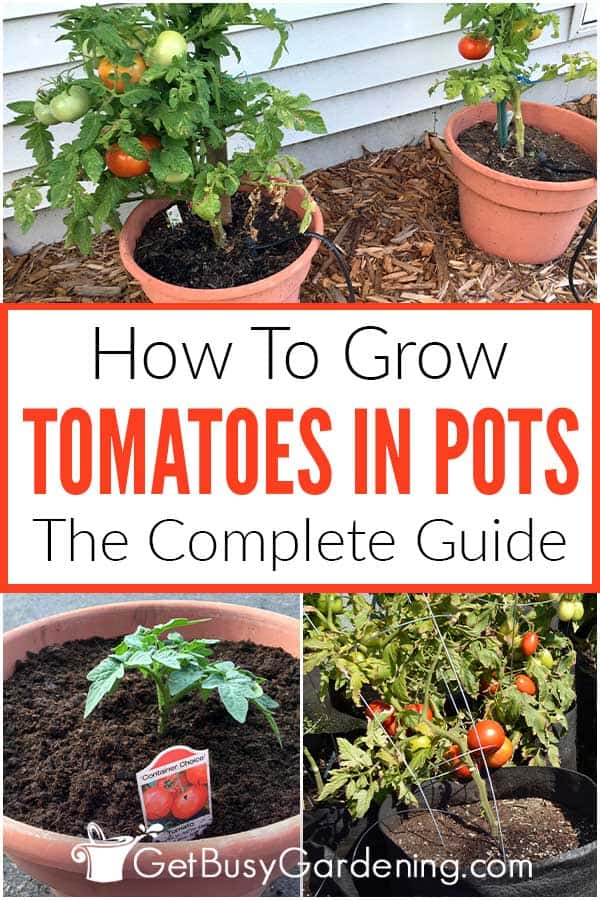


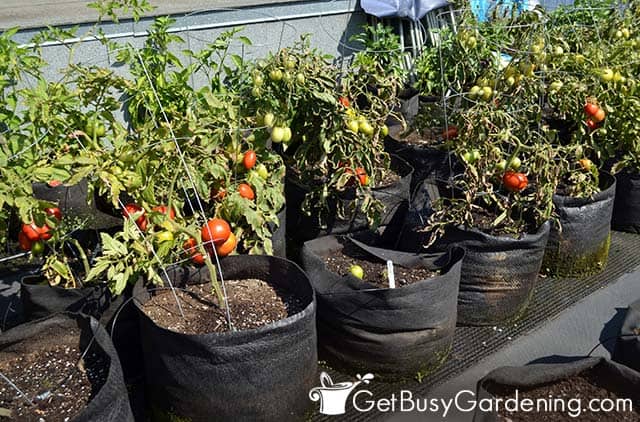
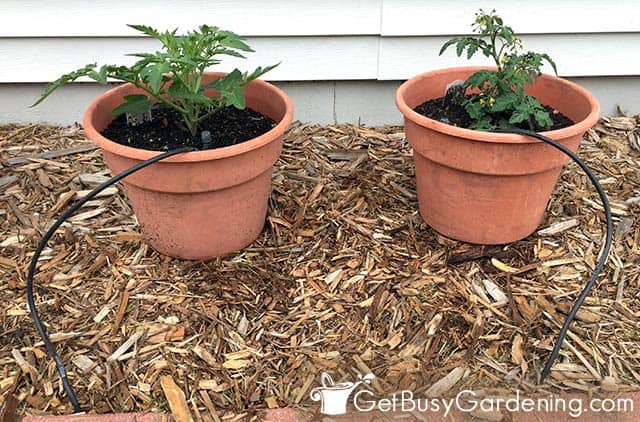
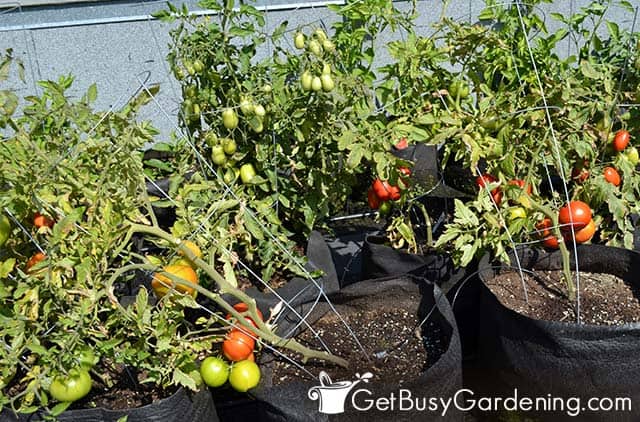


Dianne says
I think my pot maybe to small, growing better boys. Can I transfer to bigger pot? Plant is probably 2 to 2.5 tall. I have flowers and tomatoes starting.
Amy Andrychowicz says
Unless you have some kind of a hybrid, then your better boy tomato plant is a large indeterminate, which usually does better in the ground than in a pot. However, if you have a very large container, then it will do fine in there – it just won’t get as large or produce as much as it would in the ground.
Cterry says
I’m trying tomatoes in grow bags.what tips to have a healthy crop?
Amy Andrychowicz says
Grow bags are just another type of pot, so you can follow the instructions in this post for your tomatoes. The only difference is that if your bags are fabric, they will dry out faster than plastic. So you’ll need to water more often.
Howellen says
I new at growing tomato plants , I’m doing them in containers but I’m wondering how big the plants need to be before putting them in the pot they will stay in for the summer. Mine now are in 4” pots and about 6” tall, are they ready to transplant? Thanks
Amy Andrychowicz says
You can plant your tomatoes into the pots they will stay in all summer as soon as it’s warm enough outside, and all chance of frost is gone.